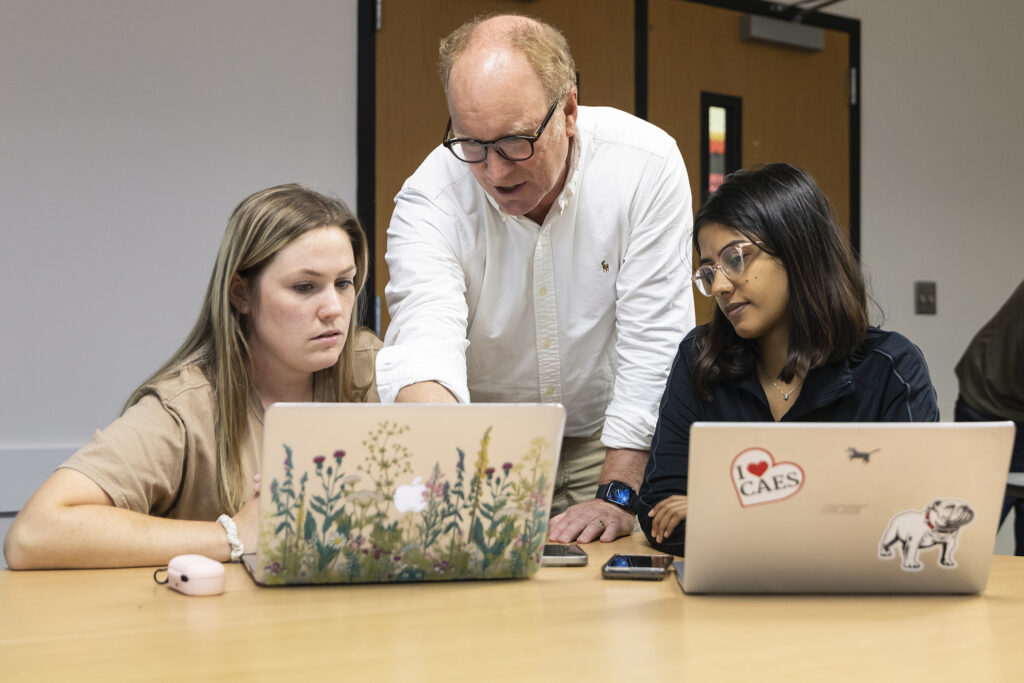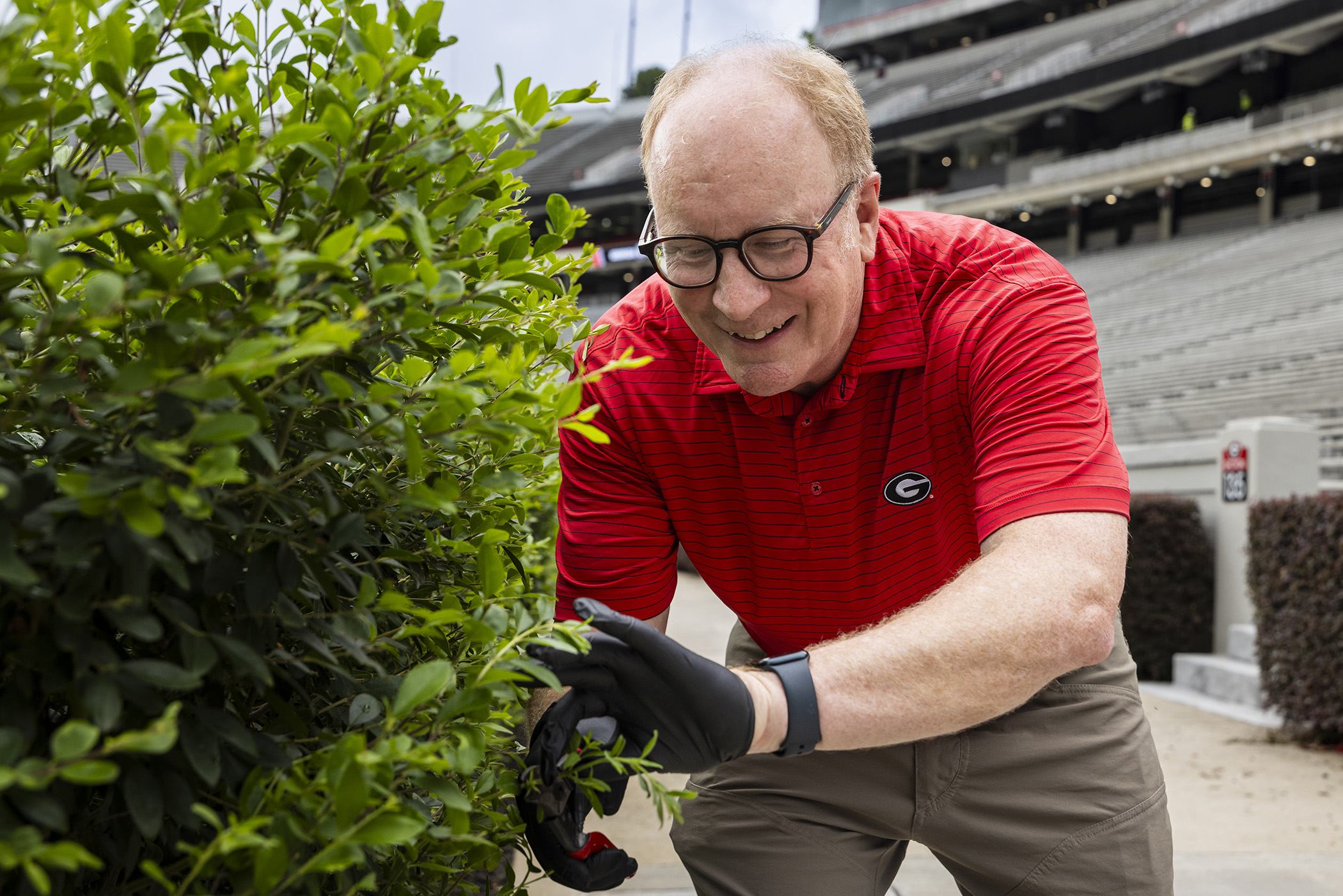The iconic stretch of greenery that spans across Sanford Stadium just got a major ancestry test.
And after a careful whole genome analysis—forged by a love for the hedges and UGA history—a Franklin College of Arts and Sciences faculty member and his students found that the same family of hedges have stood tall for nearly 100 years.
Becoming privy to the privet
Plant biology professor and hedges researcher James Leebens-Mack decided to sequence the genome of the Sanford Stadium hedges. His goal was to combine service-learning with his own areas of research, comparative genome biology and the Chinese privet. It just so happens the Sanford hedge species is a member of the olive family, which contains the privet.
So Leebens-Mack, bioinformatics course co-teacher and Georgia Research Alliance Eminent Scholar Arthur Edison, and their students assessed the genome of the Sanford Stadium hedges.

The genes and chromosomal structure of the Chinese privet has changed relative to its ancestors over millions of years, so how has UGA’s botanical mascot shifted over the past century?
“I knew that in the olive family there was missing knowledge about privet genome evolution. I also knew the genome could provide clues to how we reduce the privet’s impact as an invasive species here in the eastern U.S.,” Leebens-Mack said. “The genome that we generated for the Sanford Stadium hedges advances both foundational understanding and practical horticultural practices. There is something in the genome that we can target to control privet as a pest plant.”
History of the hedges left much to be discovered
In addition to comparing the hedges with the types of environments they grow in, Leebens-Mack tested whether the hedges in Sanford Stadium today were genetic clones or cousins of the hedges first planted in 1929.
When they were removed from the stadium for the Atlanta Olympics in 1996, it had been close to 70 years since the original hedges were placed in Sanford Stadium. Clippings were taken and kept in nurseries and replanted after the Olympic games, but no one checked to verify that the plants in Sanford Stadium today are truly clones of those removed in 1996.
Until now.

Leebens-Mack and Edison’s students confirmed that today’s hedges are from the same stock as their predecessors with nearly identical genomes. That’s not to say that there isn’t some minor variation among the plants growing in the stadium.
“This work on the Sanford Stadium hedges is helping us understand their history while filling in a gap in the availability of high-quality genome sequences across the flowering plant tree of life,” said Leebens-Mack.
Clipping and collecting the data was a team effort
Leebens-Mack and UGA alumnus Philip Bentz collected clippings from the hedges on both sides of the field every 30 yards. The tops of the hedges (the “young” part of the clippings) were tucked in liquid nitrogen to ensure the DNA would not degrade ahead of sequencing.
From there, UGA alumnus Alex Harkess sequenced the clippings at the HudsonAlpha Institute for Biotechnology in Huntsville, Alabama. HudsonAlpha partners with the UGA Graduate School to provide dissertation research opportunities for UGA students, so this project was an easy extension of that educational collaboration.
Once the sequencing of the clippings was complete, Leebens-Mack’s students compared stretches of DNA. Students also compared their genome sequence with other plants in the olive family to see how the privet genome has evolved over the years.

“This type of authentic scientific research is integral to the student learning experience for science courses at UGA,” said Leebens-Mack.
That means the hedges you know and love are consistent genomically across nearly the last 100 years. This sequence holding all this time means that the fans who were lucky enough to receive their own pieces of clippings ahead of the Olympics changes can rest easy. Their privet plants are the original.
It doesn’t always have to be a pest plant
The UGA hedges also provide an opportunity to see the privet as more than a pesky weed.
“Sanford is such a gorgeous stadium, and we hope our research will help maintain that because now we know what the groundskeepers have been doing works,” Leebens-Mack said. “Our findings could also help groundskeepers continue to maintain these plants in Sanford Stadium as they have been since 1929!”
More generally, the genome data is useful for both botanical researchers and gardeners who can learn what has worked. Privets do not have to be problematic weeds; they can be your own personal Sanford hedges.
“There’s an opportunity here. We can encourage homeowners to trim their privet plants like they trim the plants at Sanford. And knowing how much genetic variation there is among the hedges, we can have a better idea of useful growing techniques and horticultural techniques. We can make sure the hedges in the stadium today stay healthy,” he said.
The phrase “between the hedges” is one that endures across generations of students and fans at UGA. Still, that changing set of fans is what keeps the Bulldog spirit so long lasting.
Now, it’s been proven the hedges are just as enduring.


